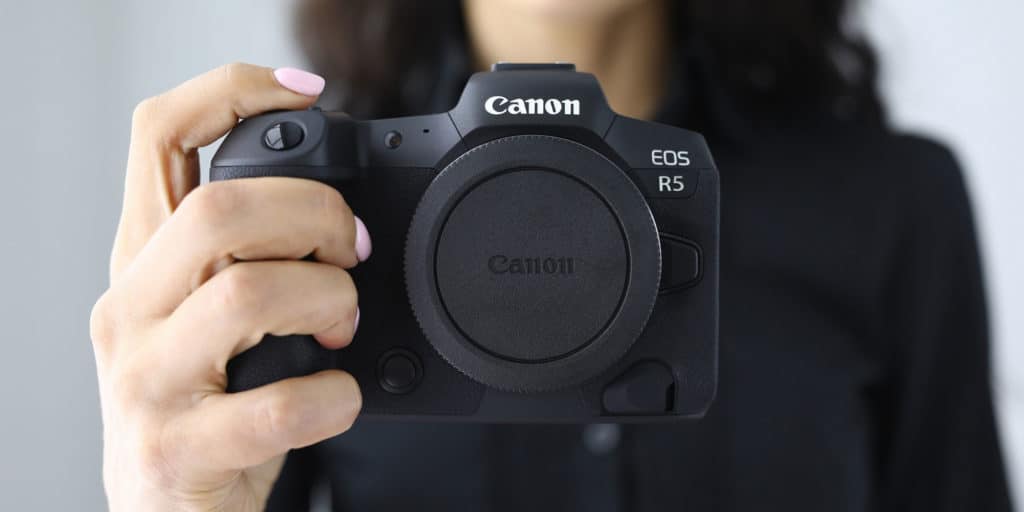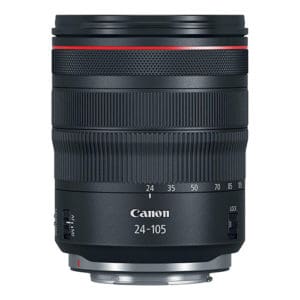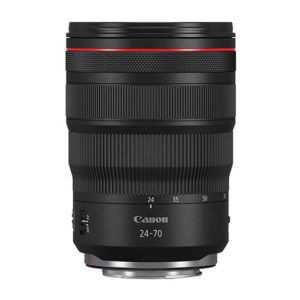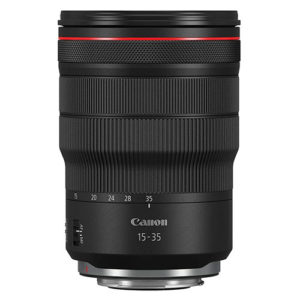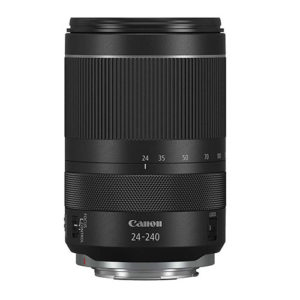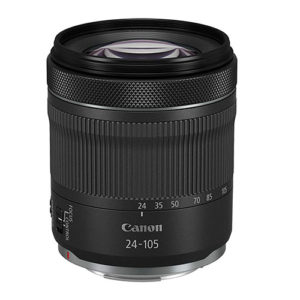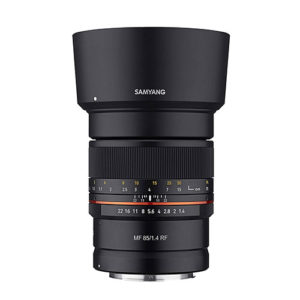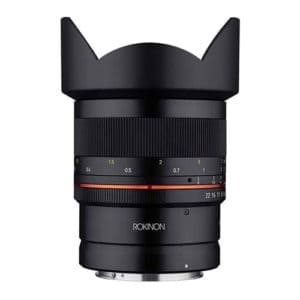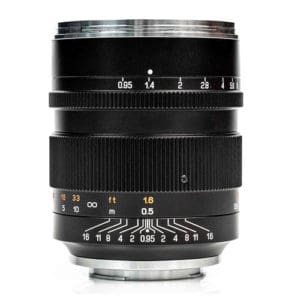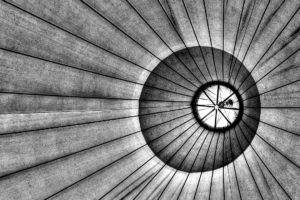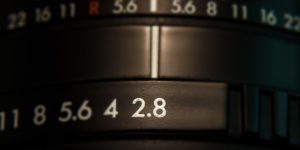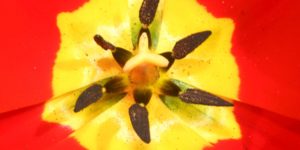The photography world is abuzz with excitement over Canon’s first competitive full-frame mirrorless cameras.
These fully capitalize on all of the advantages that mirrorless offers–they’re compact, lightweight, and great for video. Along with these new cameras, Canon has begun redesigning their famous L-series lenses to fit them.
The results are great lenses that are better than ever, all while getting lighter and smaller.
So which lenses should you choose to go with your new Canon EOS R5?
Here are a few of my thoughts on the best lenses for the EOS R system.
Best Kit/Everyday Lens – Canon RF 24-105 mm f/4L IS USM
Picking a great everyday lens is a tough job, but Canon makes it easy with this masterpiece.
This is the redesigned RF-version of the L-series classic.
I carried this lens in its EF-form for many years, and I was never disappointed.
The 24 mm provides just the right wide-angle capabilities, while the 105 mm is close enough to make this an outstanding portrait lens.
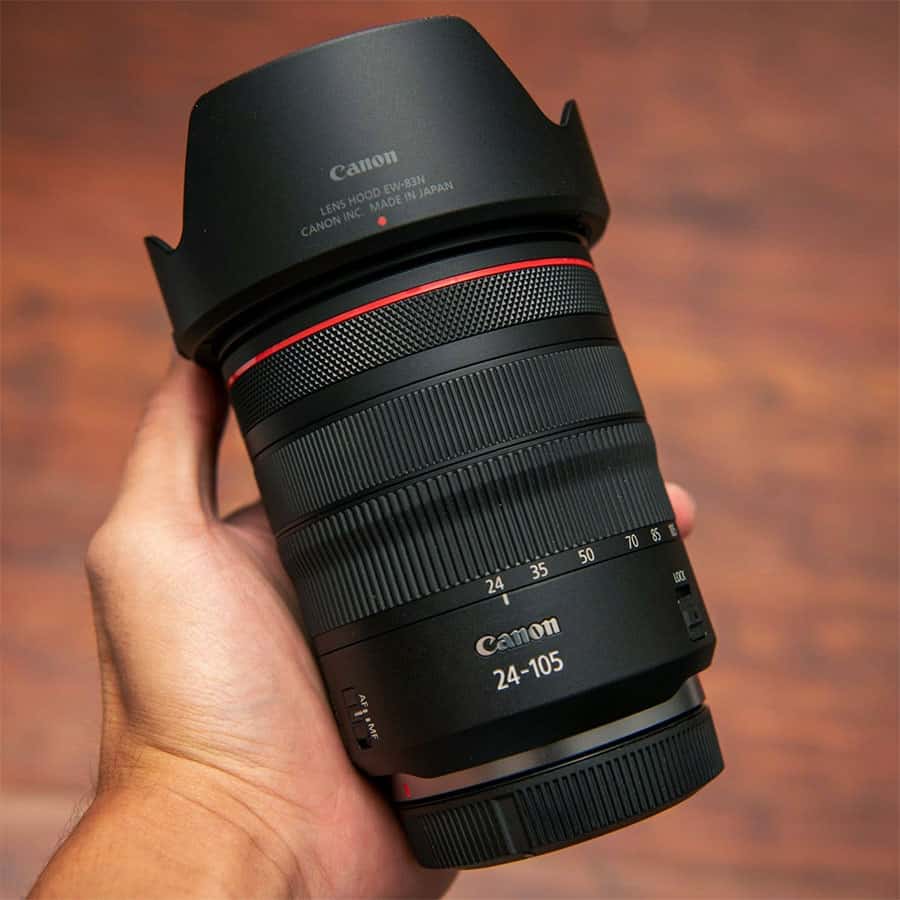
With a constant f/4 aperture, this lens is fast enough to be useful often but still small enough to carry around wherever you go.
At 700 grams, it’s hefty but not ridiculous; it takes 77 mm filters, a common feature of L-series lenses.
It has built-in IS to help out in low-light situations. Canon says that their IS can lead to a five-stop improvement in reducing hand shake.
Like the other Canon RF lenses, the 24-105 features a multi-purpose control ring that allows you to control things like shutter speed or aperture with the outer lens ring.
Best Standard Zoom – Canon RF 24-70 mm f/2.8L IS USM
The f/4L lens above has a superb zoom range, but for the best low-light capabilities, the best shallow depth of field portraits, and excellent bokeh, the 24-70 f/2.8L is the lens of choice of most professionals working with the R5.
Indeed, if you only want to have two lenses in your kit, most photographers would choose the matching f/2.8 24-70 and 70-200 lenses.
Like the EF versions before it, the RF 24-70 f/2.8L has image stabilization and a silent USM autofocus system. It’s heavy at 900 grams and accepts large 82 mm filters.
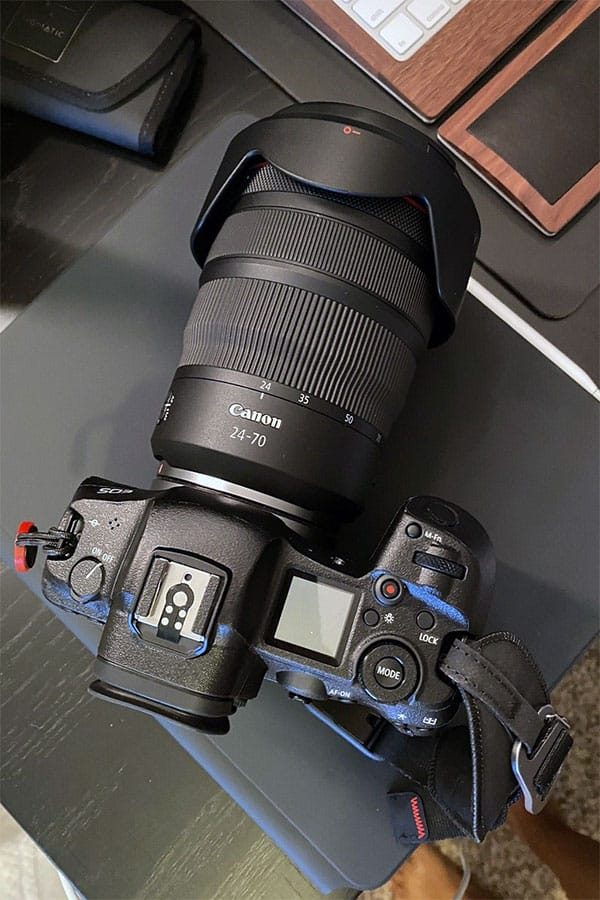
Want something even faster? Canon also offers the RF 28-70 f/2L, with a constant f/2 aperture throughout its zoom range. Notice that you give up a little bit in the wide-angle zoom range to get that extra light.
With 95 mm filters and a total weight of 1,430 grams, this lens is a big one.
Best Wide-Angle Zoom – Canon RF 15-35 mm f/2.8L IS USM
Landscape and architecture photographers will love this lens.
Quality wide-angle zooms are rare finds, and ones with fast speeds and good optics are even rarer.
The RF 15-35 creates an f/2.8 trinity, along with the 24-70 and the 70-200.
Another rare find on a lens this wide–image stabilization.
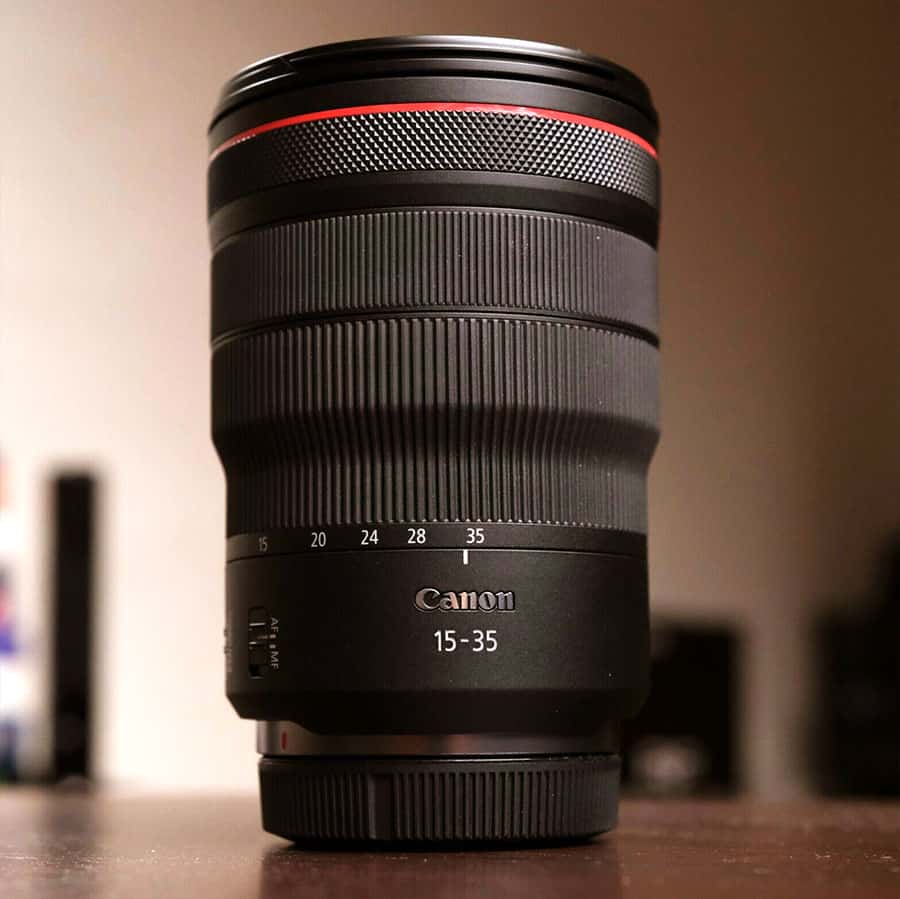
Like the other L-series lenses, this one isn’t small.
It weighs 840 grams and takes 82 mm filters.
But with such a wide field of view, this lens is perfect for photographers who are disappointed with the field of view on their 24 to 105 or 24 to 70. If the price is a little much to swallow, consider looking at a wide-angle prime to get that reduced focal length.
Best Telephoto Zoom – Canon RF 70-200 mm f/2.8 IS USM
The white color that Canon puts on their telephoto L-series lenses is distinctive. Why? Because it’s a distinctive lens that’s worthy of notice.
The RF 70-200 f/2.8 is surprisingly compact compared to the older EF 70-200, mostly because it gets longer as you zoom in, unlike previous versions. But you still get a constant and wide f/2.8 aperture through the entire zoom range.
That makes the RF 70-200 one of the best portrait lenses around. It also features a three-mode image stabilizer system for hand-held still or tracking shots, making it a great choice for quick-moving hand-held sports shots.
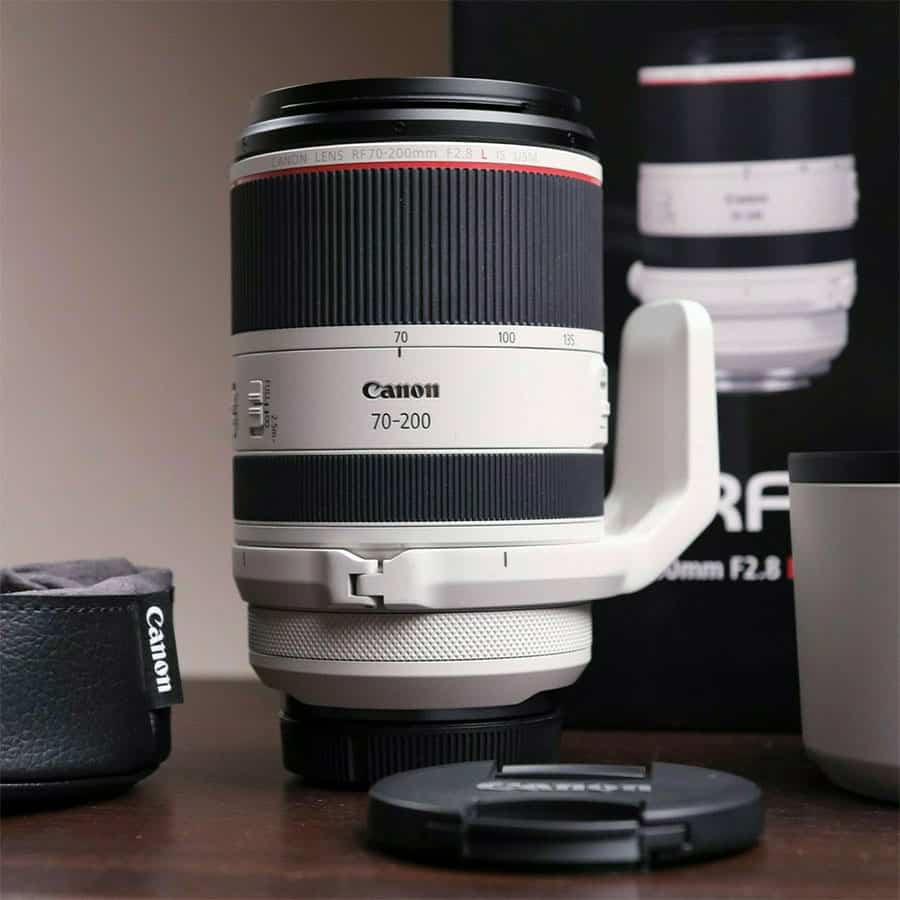
It weighs 1,070 grams and ranges from 5.75 to 8.05 inches in length.
It takes 77 mm filters, a nod to Canon’s efforts to make this lens as small and light as possible.
This lens is nearly a full pound lighter than the EF version. If you’d like something even smaller, Canon makes the super-compact RF 70-200 mm f/4L IS USM that comes in at under 700 grams and five inches long.
If you need even more reach in your zoom lens, the RF 100-500 mm f/4.5-7.1L IS USM is the answer.
This lens is perfect for birders or sports photographers, though, with the f/7.1 aperture at 500 mm, you’ll need to make sure the IS is performing perfectly if you don’t have a tripod.
Best All-In-One Super Zoom – Canon RF 24-240 mm f/4-6.3 IS USM
Super-zoom lenses are handy if you can only have one lens, and you often find yourself doing a little of everything.
The RF 24-240 mm doesn’t have a constant aperture, and it isn’t an L-series lens. This lens is designed to be small and easy to carry around, making it a good choice for travel photography.
It has a minimum focus distance that ranges from only 1.64 to 2.56 feet, too. That makes it a contender for macro photography, even if the lens isn’t branded as such.
It’s also a good choice for shooting video, with its broad zoom range and new-style Nano USM drive motors.
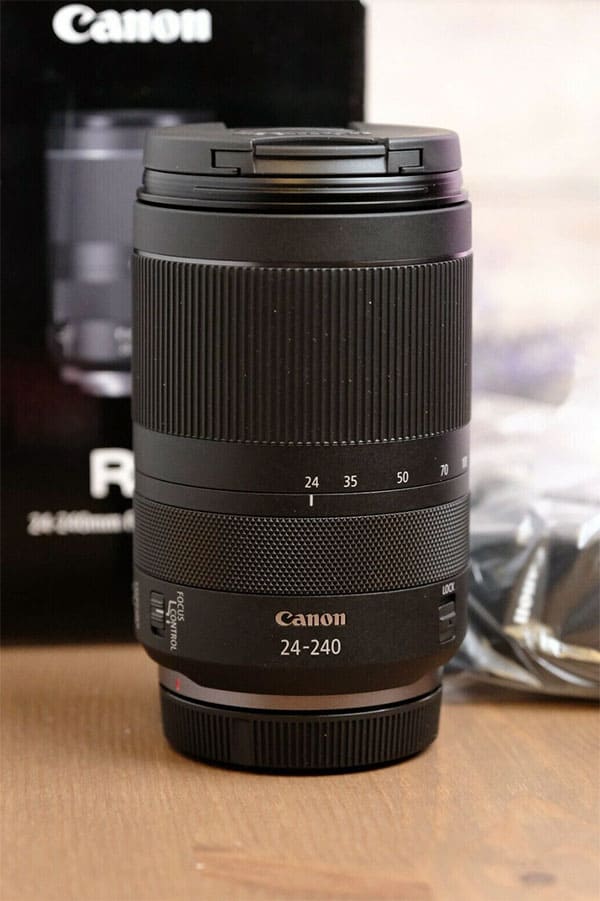
This lens takes 72 mm filters, and it folds down to a bit under five inches long and weighs only 750 grams.
The disadvantage of this lens, and other super zooms like it, is that it has distortion and vignetting at wide angles.
Lens profiles in the camera and your editing software can fix this, but generally, they will result in a cropped image.
So, in the end, you may not get to live the 24 mm wide-angle lifestyle fully.
Best Budget Travel Zoom – Canon RF 24-105 mm f/4-7.1 IS STM
Let’s face it–L-series glass is expensive.
Sometimes the best lens for the job is the one that you can afford.
Whether you’re looking for a beginner’s lens or a less expensive option to use while traveling, standard Canon lenses are still excellent.
Priced under $400, the RF 24-105 mm f/4-7.1 is comparable to the 24-105 f/4 discussed above.
The differences are that it is far cheaper, smaller, and lighter, but does not feature a constant aperture.
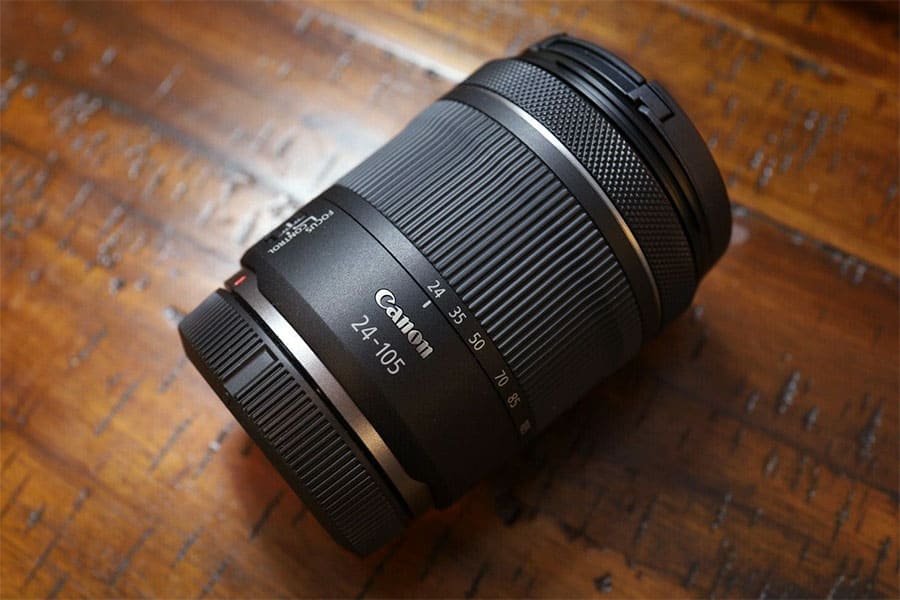
For my purposes, if I want a lens for low-light use, I usually use it on wide-angle scenes.
So having the f/4 aperture at 24 mm is perfect.
At 105 mm f/7.1, I’m more likely to be shooting portraits.
This isn’t bad, but it’s certainly not going to result in the typical shallow depth of field that you’re used to seeing in this type of photo.
Probably the most significant advantage of this lens, though, is its small size. Yes, it’s roughly a third of the price of the f/4L, but it’s also an inch shorter and weighs only 395 grams. It takes much smaller 67 mm filters.
All of that means that this lens makes the perfect travel lens–you can carry it anywhere with no complaints and still come home with beautiful images.
Budget Portrait Prime Lens (Manual Focus) – Samyang 85 mm f/1.4
Several companies are now making manual focus lenses for the EOS R-series cameras and other mirrorless systems.
Samyang is a discount brand that has made a name for itself in this area.
I’ve shot with several of their lenses, and I’m always left feeling surprised and wanting more.
The 85 mm f/1.4 is a classic portrait prime lens.
At f/1.4, it produces an appeal soft bokeh and it’s perfect for low-light conditions.
The lens is weather-sealed. It takes 72 mm filters and weighs 740 grams.
Fully manual lenses aren’t for everyone, but getting a few fast primes is a less expensive way to improve your photos if your zoom lens isn’t as fast as you like.
Budget Landscape Prime (Manual Focus) – Rokinon 14 mm f/2.8
The one place in my camera bag that I always make sure to fill is a fast, wide-angle prime lens.
Rokinon makes quite a few attractive models, but their 14 mm f/2.8 can’t be beaten for the R5 or R6.
This is a fast lens with plenty of field of view, making it my go-to for landscapes and starry sky photos.
Fast wide-angle lenses are expensive, so these budget manual focus lenses are a great way to get good-quality glass at a great price.
This Rokinon sells for well under $350, making it a superb buy for a lens that most people will only use occasionally.
The one word that describes the Rokinon’s is “surprising.”
Maybe it’s because we purchase these off-brand lenses thinking that they can’t be any good for such a low price.
But whatever our opinions were going in,
I’ve yet to meet a photographer who’s been disappointed.
They’ll often point to a lens they like better, and those lenses cost thousands of dollars more.
No, the Rokinon isn’t the sharpest or fastest in the world; it’s just a stellar value.
If you can’t stomach the idea of a fully manual lens, Rokinon has begun making autofocus versions for the RF-mount. It’s double the cost, but it does extend the usefulness of the lens to more situations.
Fastest Low-Light Prime Lens – Mitakon Speedmaster 50 mm f/0.95 III
Sometimes, you’ve just got to have a fast lens.
Another fully manual option, this time from Mitakon, the Speedmaster 50 mm has a wide-open aperture of f/0.95.
That makes this lens a must-have for street photographers shooting after dark, or even for some limited nightscape and city light photography.
Prime lens options are still somewhat limited for the EOS R system, so keep checking back with the companies to see if they’ve extended the offerings.
Canon R5 RF Lenses Guide and FAQ
How To Choose The Right Lens For Your Needs
Canon has released an impressive number of outstanding lenses for their new mount for such a new camera system.
The RF lenses lineup span enough focal lengths and budgets to make pretty much any photographer happy.
The biggest problem soon becomes just how are you supposed to pick the right ones?
Picking the lenses you will use most often is a balancing act. You need to consider several factors before you invest your hard-earned cash into an expensive chunk of glass.
The primary determining factor of whether or not a lens will work for you is the focal length.
If you’re shooting landscapes, you probably want something that is wide-angle.
If you’re capturing small birds at a distance, you need a fast telephoto lens with good autofocus.
Secondary to this, you also want to know how wide the aperture is, the lens’s size and weight, and if it fits within your budget.
All lenses compromise something.
You can get a super all-in-one lens that covers a vast range of focal lengths, but it will likely not be very fast.
You can get a high-speed lens, but it will be heavier and more expensive than others.
Only you can determine which combination of factors will fit right in your camera bag.
Can I Use Other Canon Glass?
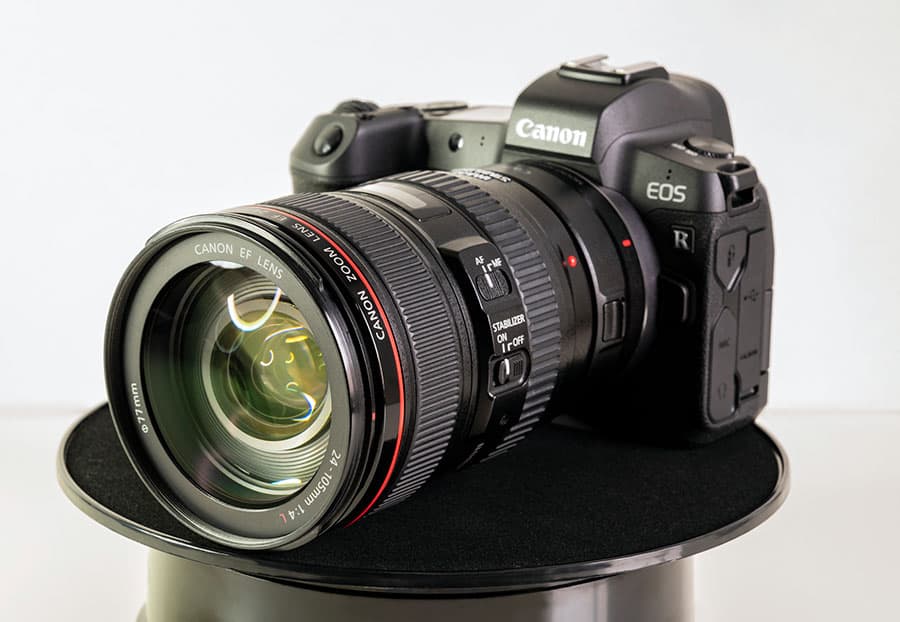
With the introduction of the RF-mount lenses, Canon is currently making four different lens mounts.
This is quite a change from a few years ago when all film and digital SLR bodies took their venerable EF lenses.
Today, Canon breaks their lens mounts down like this–
- EF–For full-frame, DSLR bodies (mostly xD-series)
- EF-S–For APS-C sensor, DSLR bodies (mostly xxD- and Rebel series)
- EOS-M–For APS-C sensor, mirrorless bodies (M-series)
- RF–For full-frame, mirrorless bodies (R-series)
If you’re just starting in the camera world, there are few reasons why you would choose anything other than RF-mount lenses.
Unless you have an eye on switching to a DSLR in the future, the RF lenses will offer you the best optics and best value for your camera body.
If, however, you are moving over from DSLRs to mirrorless bodies and already have an extensive collection of EF or EF-S lenses, you might want to know if they’ll work on your R5 or R6.
The answer is, thankfully, yes! You only need Canon’s EF-EOS R lens adapter.
It’s worth noting that Canon’s new RF mount lenses, particularly the expensive L-series models, are based on the original EF-mount lenses.
From the end-user perspective, very little separates the two, besides adding the new multi-purpose control ring and newer quieter designs of autofocus drive that are better for video.
When shopping for high-end lenses, don’t rule out the option of buying used EF-lenses and using the adapter ring.
It might be a good way to save a little cash until the RF lenses come down in price a little bit.
Focal Length and Aperture

The focal length of a lens indicates how much magnification a lens provides. The smaller the number, the broader the field of view offered.
Since the EOS R cameras maintain the original 35 mm full-frame sensor size, there is no crop factor. When you pick up a 50 mm lens, it will be 50 mm on your camera.
And since there is no crop factor, 50 mm is the magic number that produces the most true-to-life images. A 50 mm prime lens is considered a “normal prime.”
Focal lengths of less than 50 mm are considered wide-angle. The wider the field of view, the more the image must be distorted to fit on the frame. Lenses can be made the put an entire 180-degree field of view on the sensor.
But, these images are so distorted that these special-purpose lenses are dubbed “fisheyes.” Wide-angle primes between 14 and 35 mm are great for landscapes, architecture, and wide-angle portraits or group shots.
If you pick up a lens with a focal length great than 50 mm, you are zooming in. This is called a telephoto lens. If you want to shoot small objects from great distances, as wildlife photographers do, you need a telephoto lens. Primes with focal lengths between 80 and 135 mm are commonly called portrait lenses.
The aperture in the lens is much like the iris of your eyeball. It opens and closes to allow more light in. While all lenses can close their apertures very small, how wide it can open is limited by the lens’s optical size.
The bigger the glass elements inside the lens, the wider it can go, and the more light it can let it. Since wide apertures require more glass, they can be much more expensive and much bigger than other lenses.
Aperture is measured in f-stops—a small f-stop number, like f/1.4, corresponds to a wide aperture.
Aperture not only controls how much light is let in but also the depth of field. An aperture of f/1.4 has a shallow depth of field, perfect for portraits.
We try to get the widest apertures that our budget will allow, which enables us to best control the depth of fields and shoot better in low-light situations.
Prime Versus Zoom Lenses
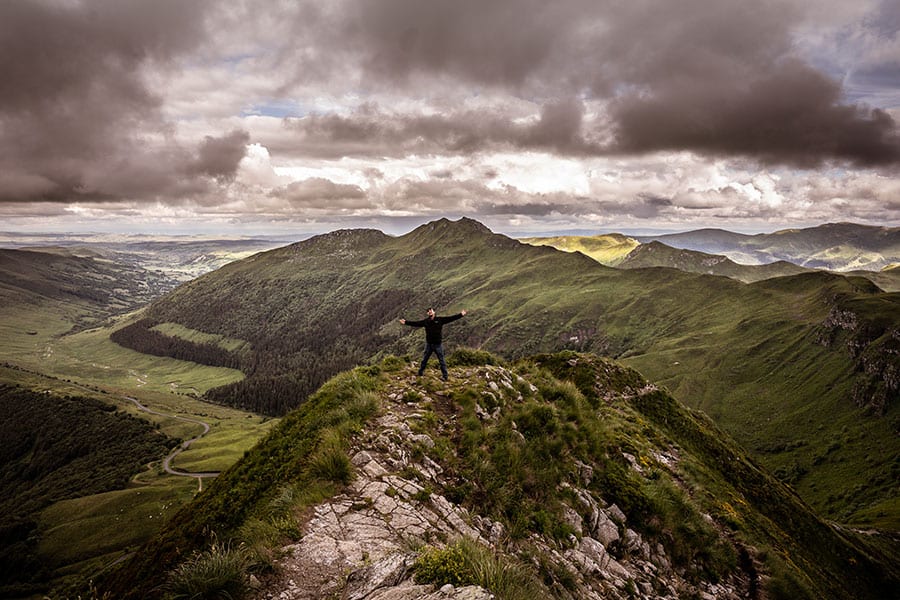
Lenses are either prime or zooms. A prime lens has a fixed focal length, while a zoom lens allows you to pick between a range of focal lengths.
Since picking between a range sounds better to everyone, why are prime lenses even a thing?
For one thing, it’s far easier for manufacturers to make a prime lens with near-perfect optics.
Zoom lenses are always compromises. They may be sharp throughout their range, but chances are there is some point where they are sharper. Most lenses lose a bit of quality as you zoom out.
Zoom lenses also tend to be slower than prime lenses. That is, they have smaller apertures. All of these reasons make prime lenses less expensive than zoom lenses in most cases.
Are Canon “L-Series” Lenses Worth the Extra Cost?
For decades, Canon has branded their premium professional lenses with a red band on the outer edge and the “L” designation.
These lenses are the best that Canon makes.
They have better optics, faster, more accurate autofocuses, and generally wider apertures. Constructed to a higher standard, they’ll also have metal bodies and better weatherproofing than other Canon lenses.
If you’re used to shooting with the cheap plastic kit lenses that come with the Rebel camera bodies, you’ll be very pleased with L-series lenses. When compared to those lenses, L-series units have smoother zoom and focus rings, along with faster and quieter autofocuses.
They also have internal focus elements, meaning the end of the lens does not spin. That’s really nice to have if you’re shooting with circular polarizing filters or variable ND filters.
So are they worth it?
That depends. L-series lenses typically do not fit the bill if you’re after a budget lens with the lightest and smallest dimensions.
But if you need a rugged, professional-quality piece of equipment with top-of-the-line optics, L-series lenses should be your first choice.
I’ve used many L-series lenses over the years, and I’ve never been disappointed by the photos.
I’ve found another great benefit to the L lenses.
They have better resale value than other lenses. There will always be a market for used L-series lenses, and that’s becoming more and more important as new camera systems become available.
Potential buyers know these lenses are built for the long-haul, and they will pay more on the used market than comparable regular lenses.
A camera like the EOS R5 is designed to have good optics mounted on it.
It’s fun to play with other lenses, but this is a serious camera with an even more serious sensor.
Mounting regular lenses on it is a bit of a shame; even the kit comes with L-series glass.
What About Manual Focus Lenses?
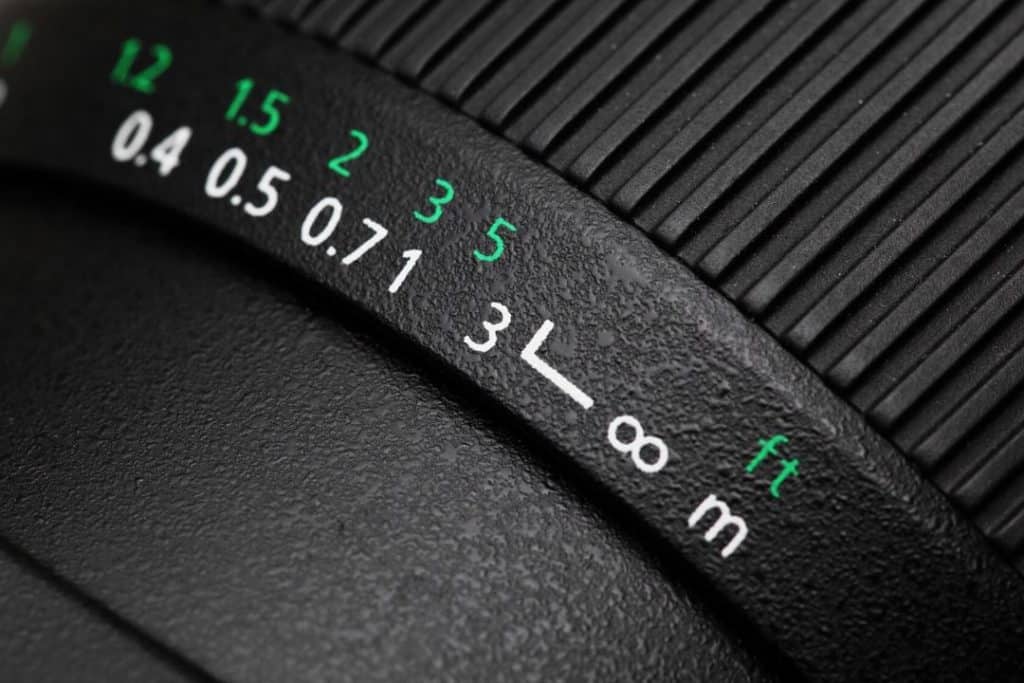
If you’re looking to shoot videos with your R5 or R6, you might want to look into manual focus lenses.
While the new USM and STM drive motors are quiet on camera, some camerawork uses pull-focus techniques while rolling.
If this is the sort of thing you’re interested in, check out the Cine series lenses made with this in mind.
For still photography, manual lenses may seem a bit outdated.
They are enjoying something of a renaissance with mirrorless camera users, though. These cameras are the perfect digital bodies to mount vintage glass on.
It’s not uncommon to see photographers manually focusing with decades-old Zeiss or Leica lenses mounted.
There are several discount brands now selling specialty manual focus lenses for the RF-mount. Some market themselves as inexpensive ways to get super-wide-angles or super-telephoto lenses for a lot less money than the Canon equivalents.
Some are high-end units that offer features Canon does not, like ultra-wide apertures.
Manual focusing might sound appealing, but it does take some getting used to.
And there are some types of photography where a good autofocus is a must-have item. Sports photography, wildlife, weddings, or event gigs are places where I would not want to be without a trusty autofocus.
These fully manual lenses lack other features, too. Nearly every Canon RF lens has an optical image stabilization (IS) system built-in.
They also have electronically controlled apertures.
The R5 and R6 have in-body image stabilization (IBIS) so not having lens IS may not be a big deal. But understand that you will have to shoot in manual mode only, or perhaps shutter-priority (Tv) mode.
Adapter Tubes for Other Lenses
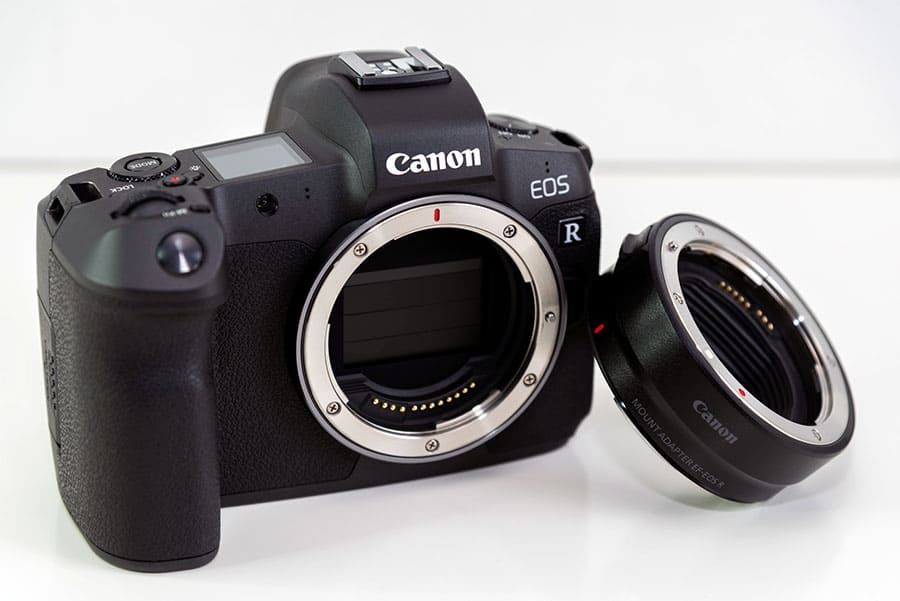
As mentioned above, mirrorless cameras make excellent platforms for using different mounting systems.
This route is fun if you want to experiment with vintage glass or other creative outlets.
Several companies make simple metal adapter rings.
They match the threads from the lens of your choice to the EOS R camera mount.
Any lenses with electronic controls will require a much more expensive adapter if it’s even made.
If you have old lens collections, mirrorless systems like the EOS R are perfect for playing with them again.
And if you want to play creatively, you can pick up many old lenses on eBay or at your local used camera shop for pennies on the dollar.
Final Words
Canon has done an outstanding job in creating the camera system of the future and creating a fantastic selection of glass for it.
The EOS R lens catalog keeps growing, with more and more options added every few months.
What lens do you like best, or which Canon R5 lenses are you still waiting for? Leave your comments below.

